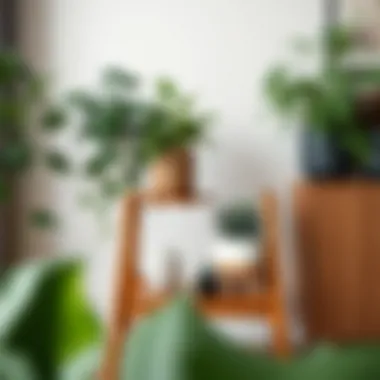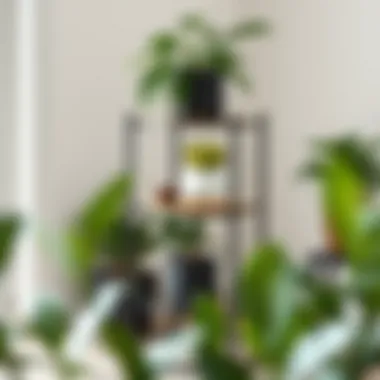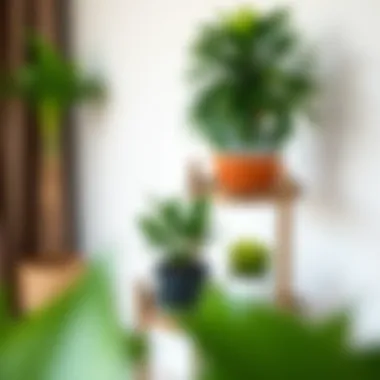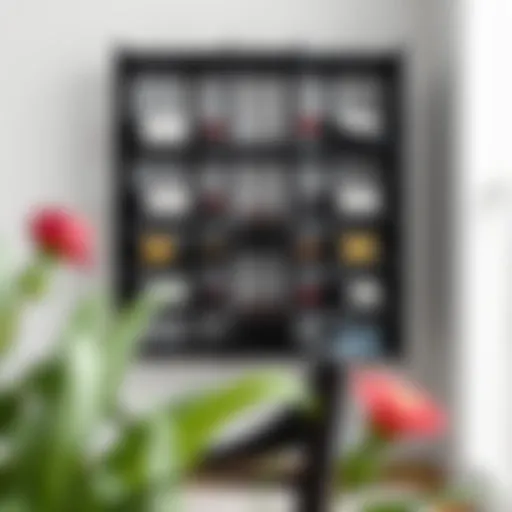Enhancing Interiors with Three Tier Plant Stands


Intro
In the realm of home design, the thoughtful integration of greenery is more than just about aesthetics; it reflects a holistic approach to living space. Prominently positioned within this trend are three-tier indoor plant stands. These structures, crafted to elevate plant displays, blend functionality with style, creating an inviting atmosphere in various interior settings. For homeowners looking to inject life into their homes further, or for designers seeking that perfect focal point, understanding the interplay of these stands within design trends is crucial.
The multi-faceted nature of three-tier stands offers versatility unmatched by simpler racks. They not only serve the purpose of plant elevation but also create dynamic layers of interest within space. A keen eye on modern design trends reveals how these stands can effortlessly transition from one style to another, harmonizing with a room's aesthetic.
Design Trends
Current Trends in Furniture Styles
As we navigate through various furniture styles, three-tier plant stands resonate with several current themes. Minimalism, with its clean lines and functional design, encourages the usage of stands that do not overwhelm but compromise beautifully with their surroundings. On the other hand, biophilic design has surged, reinforcing humanity's connection to nature by integrating natural materials and foliage into interiors. The three-tier stands can encapsulate this concept perfectly, accentuating the relationship between indoor and outdoor elements.
"Plants not only purify the air but also uplift the spirit. A well-placed three-tier stand can transform a dull hallway into a vibrant green passageway."
Mid-century modern is another dominating trend. Stands made of wood, recalling those distinct era features, pair well with vibrant color palettes typical of the time, further enriching indoor spaces. The blend of materials such as metal and wood is gaining traction, merging industrial charm with warm, organic nuances.
How to Incorporate Trends into Your Space
Incorporating this type of stand demands attention to both placement and plant choice. Use these steps to seamlessly blend stands into your interior:
- Evaluate Your Space: Look at your rooms and identify areas that could benefit from some greenery. Staircases, corners, or even dining tables can be ideal spots.
- Plant Selection: Choose plants that suit the light conditions of your space. Succulents, ferns, and flowering plants can be ideal choices, each offering varied colors, textures, and shapes that draw the eye.
- Style Coordination: Match your three-tier stand with existing furniture. A dark wood stand often complements lighter décor styles, while a sleek metal finish might work wonders in a contemporary setting.
- Layering Approach: Display plants of different heights and growth habits. This layering not only enhances visual interest but also improves light access to all plants, fostering their growth.
Buying Guides
Choosing the Right Furniture for Different Rooms
Selecting the right three-tier indoor plant stand can make all the difference in how your plants are showcased. Here’s how to choose the right one for each room:
- Living Room: Opt for stands with a sturdy base to ensure stability. Consider materials that match your existing furniture for a cohesive look.
- Kitchen: Aluminum or metal stands are ideal due to their moisture resistance and ease of cleaning. Incorporate smaller, compact versions that won't take up too much space.
- Bathroom: If you're elevating humidity-loving plants like ferns or peace lilies, choose stands that can withstand the moisture levels typically found in bathrooms.
- Bedroom: A tiered stand made from soft wood finishes can add warmth. Place cascading plants that contribute to a calming atmosphere.
Tips for Assessing Quality and Value
Quality and longevity should be paramount when selecting a stand. Here are some points to consider:
- Material Durability: Ensure the materials won't warp or degrade over time. High-quality wood, powder-coated metal, and treated finishes are essential for longevity.
- Weight Capacity: Evaluate how much weight the stands can handle. Heavier pots require sturdier constructions.
- Design Versatility: Choose stands that align with different decor styles, offering flexibility as your design evolves.
- Reviews and Recommendations: Check platforms like Reddit or specialized design blogs for user experiences before making your purchase.
Ultimately, three-tier indoor plant stands are more than mere furniture. They act as living art pieces in a home, enhancing the beauty of live plants while providing practical benefits for maintenance and growth. Engaging with these multi-layered stands invites a refreshing perspective on interior design, inviting nature into the everyday.
For more about interior design trends, visit Encyclopaedia Britannica.
Preamble to Indoor Plant Stands
In recent years, indoor plant stands have not just become a decorative addition to homes, but have evolved into essential elements of interior design. One particular trend capturing attention is the three tier indoor plant stand, a structure that cleverly utilizes vertical space while presenting greenery aesthetically pleasing. These stands serve multiple purposes that blend functionality with beauty, appealing to homeowners looking to incorporate nature into their living spaces without sacrificing style.
Definition and Purpose
Indoor plant stands are furniture pieces designed specifically to hold potted plants. Among these, three tier stands stand out for their unique design. Characterized by three levels or tiers, these stands offer various advantages. Primarily, their purpose is to enhance the visibility of plants, ensuring they gain adequate light exposure while also being more accessible for care and maintenance. A well-placed three tier stand can transform even the smallest corner of a room into a vibrant oasis, allowing plants to thrive and contribute to the air quality of indoor spaces.
"Incorporating greenery into home decor not only elevates aesthetic appeal but also fosters an environment conducive to well-being."
Growing Popularity in Modern Homes
The surge in popularity of indoor gardening coincides with a broader lifestyle trend towards sustainability and wellness. With urban living spaces getting smaller, many homeowners are searching for ways to bring the outside in and make use of every nook and cranny available. Three tier indoor plant stands have emerged as a favored solution, facilitating a lush greenery display while being compact enough to fit into limited spaces.
Moreover, the growing awareness of the mental and physical benefits of plants has spurred interest in cultivating indoor gardens. Notably, plants are known to improve air quality and boost mood, making their presence within a home not only beneficial but essential in many contexts. As people become more design-conscious, they are looking for furnishings that reflect their values and enhance their lifestyle. Thus, three tier stands serve as a practical solution that meets both aesthetic desires and functional needs, highlighting the fusion of nature with contemporary living.
Three Tier Plant Stands: An Overview


Three tier indoor plant stands represent a simple solution to an increasingly complex challenge: day-to-day indoor gardening in limited spaces. Beyond their functional role, they contribute immensely to the overall decor and ambience. This section delves into the distinct design elements and functional benefits that these stands offer, aiding homeowners and interior designers in making informed choices for their spaces.
Design Elements
Design plays a pivotal role in the appeal and functionality of three tier plant stands. It's about striking the right balance between aesthetics and practicality.
Tier Configuration
When we speak of Tier Configuration, we refer to the layout and arrangement of the tiers. A common setting would be a triangular or staggered layout, where plants of different sizes can be displayed harmoniously. This configuration not only looks visually appealing, but also allows for better light distribution to each plant. This is especially important for those plants that aren't just pretty faces; they require a little more TLC when it comes to sunlight.
A key characteristic of tier configuration is its flexibility. Whether you’ve got a small spider plant or a tall snake plant, the configuration can be adjusted to suit different sizes. One downside to be aware of is that if not arranged thoughtfully, some lower tiers might miss out on light if overshadowed by taller plants above.
Material Options
The Material Options used in constructing these stands can sway both their durability and aesthetic appeal. Common choices include wood, metal, and plastic. Wooden stands are timeless, conveying a warm and rustic charm, while metal options can exude a more contemporary feel. Each choice has its strengths and weaknesses.
For instance, a wooden stand can provide a cozy, inviting environment, but moisture can warp wood over time if not treated properly. Conversely, metal is sturdy and often has a sleek finish but can sometimes be too cold for certain decor styles. Balance is key when selecting material to harmonize with your indoor theme.
Size Variability
The Size Variability of three tier stands means that they come in myriad dimensions, making them suitable for small nooks or spacious living rooms. A compact model can make the most out of a snug corner, while a grand design can become a striking focal point.
What’s more, within this variability, you can find unique features such as height adjustability or collapsible designs which cater to both practicality and personal preference. A potential downside may be the risk of sizing issues; a stand that feels perfect online might not quite fit once you have it in your space.
Functional Benefits
Three tier plant stands are not just about looks. They offer a range of functional benefits that make them a worthwhile addition to your home or office.
Maximizing Space
One of the most appreciated benefits of these stands is their ability to Maximize Space. By utilizing vertical rather than horizontal surface area, homeowners can fit more plants into a single area without overcrowding. This space-saving capability is perfect for small apartments or rooms with limited floor space.
A notable characteristic of this benefit is the way it encourages vertical gardening—an approach that can open a whole new world of plant ownership. However, over-crowding plants could lead to less air circulation, so it’s an aspect to manage carefully.
Improving Airflow
Having plants stacked at varying levels allows for Improving Airflow around the foliage. With an organized setup, air can circulate freely, reducing the risk of mold or mildew that might occur with your beloved greenery. This not only keeps plants healthier but can also enhance the aesthetic by showing off the full beauty of each plant.
One consideration here is that certain plants require higher humidity, so placing them on stands might expose them to lower moisture levels than what they are accustomed to. Careful selection of plant types can help navigate this issue.
Facilitating Plant Growth
Lastly, tiered stands can be vital in Facilitating Plant Growth. Different tiers can be strategically used based on plants’ unique light and water needs. Lower tiers might work better for shade-loving plants while allowing those at the top to bask in the sunlight.
The flexibility to arrange plants as per their needs can greatly enhance the overall health and growth trajectory. A potential downside is that not all plants will thrive equally in every setup, so a mindful approach is recommended.
Aesthetic Appeal in Interior Design
A three tier indoor plant stand can truly redefine the way we perceive interior spaces. The importance of aesthetic appeal in design cannot be overstated, especially when it comes to integrating living elements like houseplants into our environments. These stands not only serve a functional purpose but also enhance the visual dynamics of rooms. They can transform a mundane corner into a vibrant tropical oasis or a dull hallway into an inviting gallery of greenery.
Enhancing Space with Greenery
Greenery brings life and warmth into any space, and three tier plant stands elevate this effect to new heights. By drawing the eye upwards, these stands create a sense of flow, making rooms appear larger and more open. Plants placed at varying heights create visual interest, breaking the monotony of flat surfaces. For example, a three tier stand might host cascading vines at the top tier, complemented by medium-sized ferns on the middle tier, and a few succulents on the bottom. This arrangement not only showcases diverse plant forms but also injects texture and depth into the room’s design.
Additionally, the act of caring for plants can foster a deeper connection with one’s living space. As plants thrive and grow, they create a dynamic aspect to interior design, as they change over time. Homeowners can choose their plants according to the seasons or changing trends, thus enabling a flexible aesthetic that responds to the environment.
Color Schemes and Textures
The colors and textures of the plants, combined with the materials of the stand itself, open up a whole realm of design possibilities. For instance, using a rustic wooden three tier stand can beautifully contrast with lush, green fern leaves, creating a cozy farmhouse aesthetic. Meanwhile, a sleek metal stand could lend a modern touch, allowing vivid flowers like vibrant orchids or colorful bromeliads to stand out.


When selecting plants, consider their hues and how they interact with the rest of your decor. Brightly colored leaves or blooms can either be a focal point or a subtle complement to the overall color scheme. Textures also play a vital role. The rough bark of one plant can juxtapose beautifully against the smooth leaves of another, creating a tactile experience.
- A few examples to think about:
- For a calming palette: Choose plants with soft greens and pale pastels like the petite Blue Star Fern aligned with creamy white blooms.
- For drama: Introduce deep burgundy or vibrant magenta flowers amidst darker foliage for a striking effect.
Integrating three tier plant stands into your home isn’t merely about function. It's about creating a symbiosis of life and art, enhancing the aesthetic value of your surroundings while promoting a healthy living environment. Thoughtful placement and selection can lead to a harmonious interior that welcomes life into everyday living spaces.
Top Materials for Indoor Plant Stands
When considering the design and function of indoor plant stands, the materials used are crucial. They not only determine the aesthetic appeal but also the durability, maintenance needs, and suitability for various plant types. Let's delve deeper into this significance by examining the three main materials: wood, metal, and plastic, each with its unique characteristics and benefits.
Wood: A Classic Choice
Wooden plant stands have stood the test of time thanks to their beauty and versatility. Many people lean towards wood due to its natural charm, easily fitting into various decor styles.
Sustainability Considerations
Sourcing sustainable wood is vital in today's eco-conscious world. Many manufacturers now prioritize using reclaimed or responsibly sourced timber, which means less impact on forests and natural habitats. Choosing sustainable wooden stands not only promotes ecological balance but also supports local economies. While they might come at a premium, the long-term benefits for the environment make it a worthwhile investment. One could argue that opting for sustainable materials is as much a reflection of personal values as it is a practical choice for decor.
Finishing Techniques
The finishing of wooden plant stands plays a significant role in their overall look and longevity. From oil finishes that enhance the grain to water-based varnishes that provide a protective layer, the choice of finish can dramatically change the feel of the stand. Each technique has its pros and cons; for instance, oil finishes may require more upkeep but showcase the wood’s natural character beautifully. By choosing the right finish, one can enhance the durability and aesthetic appeal, making it well worth one's consideration.
Metal: Modern and Minimalist
Metal plant stands offer a sleek, contemporary look that can elevate any space. Their structural integrity allows them to support heavier pots without the risk of warping or breaking that wood might face over time.
One of the main benefits of metal is its durability. A well-crafted metal stand can last years, enduring the wear and tear of an active household. Plus, metal comes in various finishes like matte, gloss, or brushed, allowing for customization that fits a range of tastes.
However, one downside is that metal can be prone to rusting if not properly treated, especially in humid conditions. It’s essential for buyers to be aware of maintenance needs to ensure their metal plant stand keeps shining bright for years to come.
Plastic: Versatile and Lightweight
Plastic stands are often overlooked, but they bring an array of benefits that shouldn't be dismissed. They’re incredibly lightweight, making them easy to move around based on your changing plant needs or design layouts. In addition, plastic comes in virtually any color, giving homeowners a lot of creative freedom.
Moreover, plastic stands are typically resistant to water damage, making them an excellent option for those lush, tropical plants that require frequent watering. However, the downside is that less expensive plastic models might not be as durable and can fade over time under direct sunlight. Quality matters when deciding on a plastic stand, as not all are created equal and can impact the aesthetics of your indoor garden.
"Choosing the right material for a plant stand boils down to personal style, budget, and intended function. Each option brings complimentary strengths and highlights in every home."
Each material offers distinct advantages and hurdles to overcome. It's essential for homeowners and design enthusiasts alike to assess their needs carefully, weaving practicality with style. The right choice can end up being the linchpin in a well-designed indoor garden.
Selecting the Right Plant for Each Tier
Choosing the right plants for your three tier indoor plant stand can be the difference between a tangled mess of foliage and a verdant display that enhances your living space. This aspect is crucial not only for the aesthetic of your home but also for the health of the plants themselves. Each tier can accommodate different plants based on their light requirements, growth patterns, and overall size, enabling you to create a harmonious arrangement that flourishes. Here’s what you need to know:
Understanding Light Needs
Plants, much like people, have varying levels of preference for sunlight. Some bask in the sun’s rays, while others thrive in the shade. When selecting plants for each tier, it’s vital to evaluate the light availability in your space.
- Top Tier: Often, the top tier of your stand receives the most light, whether it’s direct from a window or indirect from the surrounding area. Use this space for sun-loving plants such as succulents or cacti, which need bright conditions to thrive.
- Middle Tier: The middle tier serves as a happy medium, where you can place plants that prefer moderate light. Options such as pothos or spider plants can flourish here, as they can adapt to a variety of lighting scenarios, still reaching for the light sufficiently.
- Lower Tier: The lower tier is typically the dimmest, where you might consider shade-loving plants. Ferns, snake plants, or peace lilies do well here, as they can survive with less light, often thriving in conditions where other plants might struggle.
As a rule of thumb, observe the light patterns in your environment before committing to any plant placement. This simple yet essential step can dramatically impact the growth and vibrancy of your greenery.
Considering Plant Size and Growth Patterns
When filling your three tier stand, it's also important to think about the size and expected growth of the plants you choose. Selecting plants with appropriate size will not only maximize the use of space but also enhance the visual dynamics of your arrangement.


- Height Variability: Taller plants should generally be placed at the top tier to avoid overshadowing shorter plants. Think of tall snake plants or development-prone ficus. On the other hand, trailing plants or smaller, more compact varieties can enhance the middle and lower tiers without crowding their neighbors.
- Growth Patterns: Some plants grow upward, while others spill over their pots. For instance, a pothos can trail beautifully downwards from the middle tier, while a rubber plant might prefer to grow tall.
- Spacing Considerations: Remember to provide adequate space between pots. Plants need room to breathe and expand; cramped quarters can lead to stunted growth and increased disease susceptibility. As a guideline, allow for at least a few inches of space to ensure each plant receives enough air circulation and light.
“Proper plant selection involves knowing not just what looks good together but also how well they perform in their environments.”
By understanding both light requirements and growth patterns, you can create an efficient setup that preserves the aesthetic appeal while ensuring a thriving plant community. Picking plants suitable for each tier can help your indoor garden shine brightly, encompassing both functionality and beauty.
Innovative Trends in Plant Stand Design
As homeowners and designers look for creative ways to integrate nature into their indoor spaces, innovative trends in plant stand design have taken center stage. These stands have evolved from mere functional items into statement pieces that enhance the overall aesthetic of a room. They serve multiple purposes—allowing one to showcase plants while simultaneously improving the layout of a living space. By examining modular designs and the incorporation of smart technology, we can appreciate how these trends can revolutionize plant care and interior decor.
Modular and Adaptable Designs
In today's fast-paced world, flexibility is key, and modular plant stands embody this ethos perfectly. These stands come in various configurations that can be easily adjusted to fit any space or style preference. You can rearrange, stack, or expand them according to the available floor space or the number of plants you wish to display.
Consider the advantage of having a three-tier plant stand that can transform into a vertical garden. Whenever you feel the need, you can switch it up to accommodate new plants, different growth stages, or changing decor themes. A set of modular plant stands can work together or separately. This adaptability empowers homeowners, allowing them to express their creativity while maintaining a cohesive look.
When assessing modular designs, consider materials like lightweight metal or firm composite woods that offer durability without sacrificing style. The ease of assembly and reconfiguration plays a significant role here as well. With a snap-together approach, setting up a sleek, tiered plant stand becomes an effortless task, discouraging any potential intimidation that may accompany traditional assembly methods.
"A well-designed modular plant stand allows the plant lover to play designer, encouraging fresh ideas whenever the mood strikes."
Incorporating Smart Technology
With the rise of smart homes, it comes as no surprise that incorporating smart technology into plant stands is gaining traction. Imagine being able to monitor the health of your plants from your smartphone! Smart plant stands equipped with sensors can provide real-time data about humidity, light levels, and soil moisture. This invaluable feedback allows homeowners to adjust their plant care routines proactively.
Imagine the sheer convenience of being alerted when your plant needs watering or when it may require more sunlight. Such technology not only streamlines the plant care process but also promotes healthier plants, ensuring they thrive without constant oversight. Some models even come with built-in grow lights that can be programmed to simulate optimal sunlight exposure, making it easier for indoor growers to cultivate their favorite flora no matter the seasonal changes outside.
Incorporating technology doesn’t stop at monitoring. Some plant stands can automatically water plants through smart irrigation systems, allowing those who's got busy lives to embrace their greens without the stress of neglect. These innovations facilitate a balance between nature and technology, making indoor gardening accessible to everyone, regardless of experience level.
Practical Care and Maintenance Tips
Taking on the responsibility of indoor plant care goes hand in hand with the ownership of three tier indoor plant stands. These stands not only elevate your plants’ aesthetic but also provide the necessary structure for an organized indoor ecosystem. However, their effectiveness can be hindered if not properly maintained. This section delves into the essential care practices that ensure both the plants and the stands thrive. Through regular upkeep, you can prolong their longevity and maintain the lush appearance of your indoor garden.
Cleaning Guidelines for Different Materials
Cleaning your plant stand may not be the first thing on your mind when arranging your greenery, but it plays a pivotal role in ensuring your setup remains visually appealing. Different materials often require distinct cleaning methods:
- Wood: For wooden stands, it's best to use a damp cloth with mild soap. Avoid soaking the wood, as excessive moisture can lead to warping. If the wood gets particularly grimy or stained, consider using a wood polish afterward to restore its shine.
- Metal: Metal stands can easily accumulate dust and grime. A soft cloth dampened with warm water and a little vinegar works wonders. Just avoid abrasive materials that might scratch the surface.
- Plastic: For those lightweight and versatile plastic stands, a simple rinse under warm water usually does the trick. If there are stubborn spots, a gentle scrub with soap will keep them looking like new.
Employing the right cleaning techniques not only enhances the durability of your stands but also promotes a healthier environment for your plants by reducing the risk of pests and diseases that thrive in dirt.
Adjusting Plant Placement Based on Season
As the seasons shift, so too should the positioning of your plants on the three tier stand. The light availability and temperature fluctuations can greatly affect plant health. Here’s how to navigate seasonal changes:
- Spring and Summer: During the growing months, you may want to position more light-sensitive plants higher up, where they can soak in abundant sunlight. Leafy greens and flowering plants often flourish in these conditions.
- Fall and Winter: As the days grow shorter and dimmer, consider relocating plants that require indirect light to lower tiers or areas where they receive the optimal warmth and light. Additionally, if your home feels chillier, moving plants closer to heat sources can help, but exercise caution to avoid scorching.
"Organizing plants in accordance with seasonal light patterns not only enhances their growth but preserves the aesthetics of your indoor space."
It’s always wise to observe how your plants respond to their placement. A few adjustments can lead to healthier growth and a more vibrant display.
In summary, a little effort towards the care and maintenance of your three tier plant stands and plants can go a long way. Employing these practical tips not only augments the visual harmony of your indoor garden but also ensures the vitality of your green companions.
Epilogue: The Impact of Three Tier Stands on Indoor Living
As we wrap up our exploration of three tier indoor plant stands, it's crucial to reflect on how these structures do more than simply support plants. They serve as an essential pivot in merging functional design with aesthetic appeal. Embracing these stands means recognizing their multifaceted benefits that resonate deeply with modern homeowners and designers alike.
First off, let's summarize the functional attributes. These stands maximize vertical space in tight quarters, allowing people to showcase an array of plants without sacrificing valuable floor area. They facilitate better airflow, which is vital for plant health, and encourage proper light exposure across different tiers. With so much functionality packed into a stylish framework, they serve as a practical investment for anyone looking to green up their living environment.
From an aesthetic angle, three tier stands bring a refreshing burst of life into indoor spaces. They create visually dynamic arrangements that engage the senses and enliven a room. Whether you lean towards rustic wood finishes or sleek metallic designs, these stands invite the outside world in—a trend that speaks volumes in today's interior design landscape. Homeowners can effectively create a lush oasis, even in the most modest apartments.
"A well-placed plant stand can be the thread that weaves nature into your home, creating not just decoration, but a sense of belonging to the ecosystem."
Moreover, maintaining these structures isn’t exactly rocket science. Regular cleaning and seasonally rotating plant placement ensure that their beauty remains intact. This ease of care further emphasizes that integrating greenery into our lives doesn’t have to be a chore.
As we consider the growing inclination towards biophilic design, the incorporation of three tier stands becomes clearer. They are not merely furniture pieces; they represent a lifestyle choice that embraces sustainability and aesthetic pleasure. Homeowners, designers, and DIY enthusiasts alike have much to gain from their presence. In an era defined by bustling schedules and concrete jungles, these stands provide a much-needed breath of fresh air—literally and figuratively.















